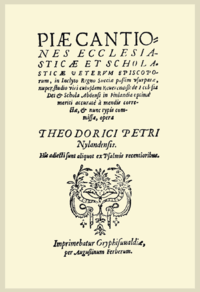Piae Cantiones

Piae Cantiones ecclesiasticae et scholasticae veterum episcoporum (in English Pious ecclesiastical and school songs of the ancient bishops[2]) is a collection of late medieval Latin songs first published in 1582. It was compiled by Jacobus Finno (Latin form) or Jaakko Suomalainen (Finnish form), a clergyman who was headmaster of the cathedral school at Turku.[2][3] Publication was undertaken by Theodoricus Petri Rutha of Nyland (Swedish form) or Uusimaa (Finnish form), who lived from about 1560 to about 1630.[4][5] He came from an aristocratic family in Finland, and was educated at Rostock.
The collection Piae Cantiones was published in Greifswald (Part of Swedish territory 1648-1815, though now in Germany) and includes 74 Latin and Swedish/Latin songs that were sung at the time in Finnish cathedral schools, most notably in the cathedral school at Turku. Most of them are religious in nature but some, for example Tempus adest floridum, are secular school songs. The lyrics in the collection testify of the moderate nature of the Protestant Reformation in Sweden. Although some Catholic nuances have been purged, many songs still carry strong traces of the cult of Virgin Mary (e.g. Ave Maris Stella). Although published as late as in 1582, the melodies of Piae Cantiones are medieval by nature. The origin of the songs and melodies varies. Many originate from Central Europe but quite a few seem to have been written in Nordic countries.
In 1625 the collection was re-published with 13 further songs.[3]
Later versions of this collection were compiled by Finns Henricus Fattbuur and Mathias Tolia. The Finnish translation of Piae Cantiones (1616) by Hemming of Masku who earlier (1605) had published a remarkable Finnish hymnal.[6] The songs of Piae Cantiones were popular in Finnish schools until the 19th century but fell gradually in disuse. However, a newly awakened interest in this old music has made them quite popular and they belong to the standard repertoire of any Finnish or Swedish choir. Many of Hemming's translations are present (with some modernization) in the official book of anthems of the Evangelical Lutheran Church of Finland. In this way, Piae Cantiones still enriches Finnish spiritual life.
Piae Cantiones in English
In 1853 the British ambassador to Sweden, G. J. R. Gordon, returned to England with a copy of the 1582 edition, which he presented to John Mason Neale, well known for his interest in early music. He in turn passed it on to Thomas Helmore who he knew to be expert in the interpretation of the mensural notation in which the tunes were given. On receiving the tunes in modern notation Neale translated the texts into English, or in a few cases wrote completely new texts. Neale and Helmore published 12 of these tunes in that same year as Carols for Christmastide, and the following year 12 more as Carols for Eastertide. The Christmas set included Christ was born on Christmas Day from Resonet in laudibus, Good Christian men, rejoice from In dulci jubilo, and Good King Wenceslas as completely new words for the spring carol Tempus adest floridum. The Easter set included Let the song be begun from Personent hodie.[4]
In Helmore's 1854 The Hymnal Noted, Divinum mysterium became, with words inspired by Prudentius' poem Corde natus ex parentis, Of the father sole begotten. Subsequent settings were made by these and other authors, such as Puer nobis nascitur (Unto Us is Born a Son) and Gaudete.
In 1910 an edition of the original, entitled Piae Cantiones: A Collection of Church & School Song, chiefly Ancient Swedish, originally published in A.D. 1582 by Theodoric Petri of Nyland, was published in England by the Plainsong and Medieval Music Society, with a preface and notes by George Ratcliffe Woodward.
References
- ↑ http://jyk.jyu.fi/jyk/kokoelmat/cantiones/deutsch/page8.shtml
- ↑ 2.0 2.1 Harald Andersen & Timo Mäkinen (1967). Piae Cantiones. Helsinki: Fazer.
- ↑ 3.0 3.1 Eileen Hadidian, A Study and Critical Commentary of Piae Cantiones
- ↑ 4.0 4.1 Margaret Vainio, Good King Wenceslas - an "English" Carol
- ↑ Robert Cummings, "Personent hodie" at allmusic, URL accessed January 4, 2009
- ↑ Mäkinen, Timo. Die aus frühen böhmischen Quellen überlieferten Piae Cantiones -Melodien. Jyväskylä 1964
External links
- Piae Cantiones - A Finnish Treasure of Medieval Songs
- Facsimile of the Piae Cantiones
- Online edition